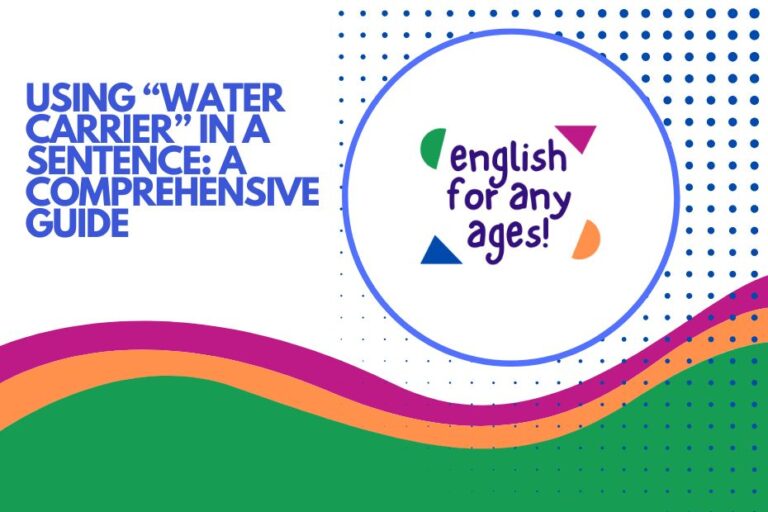How to Use “Cafeteria” in a Sentence: A Grammar Guide
The word “cafeteria” is a common noun that refers to a type of restaurant or dining area, typically in a school, workplace, or hospital, where customers serve themselves from a selection of prepared foods. Understanding how to use “cafeteria” correctly in a sentence is essential for clear and effective communication.
This article will provide a comprehensive guide to the usage of “cafeteria,” including its definition, structural elements, different contexts, common mistakes, and practice exercises. Whether you are a student, a non-native English speaker, or simply looking to improve your grammar skills, this guide will help you master the use of “cafeteria” in your writing and speaking.
This article is designed to break down the various aspects of using “cafeteria” in sentences, providing numerous examples and practical exercises to reinforce your understanding. By the end of this guide, you will be able to confidently and accurately incorporate “cafeteria” into your everyday language.
Table of Contents
- Definition of “Cafeteria”
- Structural Breakdown
- Types and Categories
- Examples of “Cafeteria” in Sentences
- Usage Rules
- Common Mistakes
- Practice Exercises
- Advanced Topics
- FAQ
- Conclusion
Definition of “Cafeteria”
A cafeteria is a restaurant or dining area where customers serve themselves from a selection of prepared foods, paying at a checkout counter. It is often found in institutions such as schools, hospitals, and workplaces. The term “cafeteria” can also refer to a similar dining area that offers a limited menu with counter service.
The word “cafeteria” is a common noun, meaning it refers to a general type of place rather than a specific one (like “Joe’s Diner”). It functions as a subject, object, or complement within a sentence, describing the location where food is served and consumed in a self-service manner. Its role is to identify or describe a specific type of dining establishment or area.
The word’s origin is complex, but it is thought to come from the Spanish word for “coffee shop,” reflecting the early role of these establishments as places to quickly and easily purchase food and drink. Over time, the concept evolved to encompass a broader range of self-service dining options.
Structural Breakdown
Understanding the structural role of “cafeteria” involves recognizing how it fits into different sentence patterns. “Cafeteria” typically functions as a noun, and can be used in various parts of a sentence, such as the subject, object, or part of a prepositional phrase.
Here are some common structural patterns:
- Subject: The cafeteria is always crowded during lunchtime.
- Object: We decided to eat at the cafeteria.
- Prepositional Phrase: She works in the cafeteria.
The word “cafeteria” can be modified by adjectives to provide more information about it. For example:
- Adjective + Noun: The large cafeteria offered a variety of options.
- Adjective + Noun: The school cafeteria serves healthy meals.
It can also be part of compound nouns or phrases:
- Compound Noun: Cafeteria food can be quite bland.
- Noun + Prepositional Phrase: The entrance to the cafeteria is on the left.
Types and Categories
While the basic definition of a cafeteria remains consistent, there are variations based on the setting and purpose. Here are some common types or categories of cafeterias:
School Cafeterias
These are typically found in schools, from elementary to high school, and often offer subsidized meals to students. They generally serve a limited menu designed to meet nutritional guidelines.
Workplace Cafeterias
These are located in office buildings or industrial complexes and provide a convenient dining option for employees. Workplace cafeterias may offer a wider variety of food choices, including hot meals, salads, and sandwiches.
Hospital Cafeterias
Found in hospitals, these cafeterias cater to patients, visitors, and staff. They often provide options that accommodate special dietary needs and offer extended hours of service.
Government Cafeterias
These are cafeterias located in government buildings, serving government employees and visitors. They may have specific regulations regarding food safety and pricing.
University Cafeterias
Found in universities and colleges, these cafeterias often offer diverse menus to cater to the varied tastes of the student population. They also function as social hubs.
Examples of “Cafeteria” in Sentences
The following tables provide examples of how “cafeteria” can be used in various contexts. These examples illustrate the different roles “cafeteria” can play in a sentence, including its use as a subject, object, and part of a prepositional phrase.
“Cafeteria” as a Subject
In these examples, “cafeteria” functions as the subject of the sentence, indicating what the sentence is about.
| Sentence | Explanation |
|---|---|
| The cafeteria is always crowded during lunchtime. | “Cafeteria” is the subject, indicating the place being described. |
| The cafeteria serves a variety of healthy options. | “Cafeteria” is the subject, indicating the place that serves food. |
| The cafeteria needs to be renovated. | “Cafeteria” is the subject, indicating the place that needs renovation. |
| The cafeteria offers a discount to students. | “Cafeteria” is the subject, indicating the place offering a discount. |
| The cafeteria was closed for cleaning. | “Cafeteria” is the subject, indicating the place that was closed. |
| The cafeteria’s menu changes daily. | “Cafeteria” is the subject, possessing a menu that changes. |
| The cafeteria provides a convenient dining option. | “Cafeteria” is the subject, indicating the place providing convenience. |
| The cafeteria’s atmosphere is very welcoming. | “Cafeteria” is the subject, describing its atmosphere. |
| The cafeteria accepts both cash and cards. | “Cafeteria” is the subject, indicating payment methods accepted. |
| The cafeteria is known for its delicious desserts. | “Cafeteria” is the subject, indicating what it’s known for. |
| The cafeteria has implemented a new recycling program. | “Cafeteria” is the subject, indicating the place with a recycling program. |
| The cafeteria’s hours of operation are posted online. | “Cafeteria” is the subject, possessing hours posted online. |
| The cafeteria features a salad bar with fresh ingredients. | “Cafeteria” is the subject, indicating a feature of the cafeteria. |
| The cafeteria offers vegetarian and vegan options. | “Cafeteria” is the subject, indicating dietary options available. |
| The cafeteria’s seating arrangement is designed for large groups. | “Cafeteria” is the subject, describing the seating arrangement. |
| The cafeteria provides a microwave for heating meals. | “Cafeteria” is the subject, indicating a provided appliance. |
| The cafeteria’s cleanliness is regularly inspected. | “Cafeteria” is the subject, indicating what is inspected. |
| The cafeteria offers a variety of beverages, including coffee and tea. | “Cafeteria” is the subject, indicating beverage options. |
| The cafeteria’s lighting creates a pleasant dining environment. | “Cafeteria” is the subject, describing the effect of the lighting. |
| The cafeteria has recently added a new coffee machine. | “Cafeteria” is the subject, indicating a new addition. |
“Cafeteria” as an Object
In these examples, “cafeteria” functions as the object of the sentence, receiving the action of the verb.
| Sentence | Explanation |
|---|---|
| We decided to eat at the cafeteria. | “Cafeteria” is the object of the preposition “at,” indicating where they ate. |
| They renovated the cafeteria last summer. | “Cafeteria” is the direct object of the verb “renovated.” |
| She manages the cafeteria with great efficiency. | “Cafeteria” is the direct object of the verb “manages.” |
| The students decorated the cafeteria for the holiday. | “Cafeteria” is the direct object of the verb “decorated.” |
| He cleaned the cafeteria after the event. | “Cafeteria” is the direct object of the verb “cleaned.” |
| The school board approved funding for the cafeteria. | “Cafeteria” is the object of the preposition “for.” |
| The chef designed a new menu for the cafeteria. | “Cafeteria” is the object of the preposition “for.” |
| I avoid the cafeteria during peak hours. | “Cafeteria” is the direct object of the verb “avoid.” |
| The committee reviewed the cafeteria’s budget. | “Cafeteria” is part of the possessive noun phrase “cafeteria’s budget,” acting as an object. |
| The staff reorganized the cafeteria for better flow. | “Cafeteria” is the direct object of the verb “reorganized.” |
| The health inspector visited the cafeteria yesterday. | “Cafeteria” is the direct object of the verb “visited.” |
| The company invested in the cafeteria to improve employee satisfaction. | “Cafeteria” is the object of the preposition “in.” |
| I recommend the cafeteria for a quick and affordable meal. | “Cafeteria” is the direct object of the verb “recommend.” |
| The event was held near the cafeteria. | “Cafeteria” is the object of the preposition “near”. |
| The construction workers repaired the cafeteria. | “Cafeteria” is the direct object of the verb “repaired.” |
| Many students prefer the cafeteria over packing lunch. | “Cafeteria” is the direct object of the verb “prefer.” |
| The smell from the cafeteria filled the hallway. | “Cafeteria” is the object of the preposition “from.” |
| The school principal addressed concerns about the cafeteria. | “Cafeteria” is the object of the preposition “about.” |
| The new lights improved the cafeteria’s ambiance. | “Cafeteria” is part of the possessive noun phrase “cafeteria’s ambiance,” acting as an object. |
| The volunteers cleaned the cafeteria after the fundraising event. | “Cafeteria” is the direct object of the verb “cleaned.” |
“Cafeteria” in Prepositional Phrases
These examples demonstrate the use of “cafeteria” within prepositional phrases, adding context and detail to the sentence.
| Sentence | Explanation |
|---|---|
| She works in the cafeteria. | “Cafeteria” is the object of the preposition “in,” indicating the location of her work. |
| The meeting will be held near the cafeteria. | “Cafeteria” is the object of the preposition “near,” indicating the location of the meeting. |
| There is a long line at the cafeteria. | “Cafeteria” is the object of the preposition “at,” indicating where the line is. |
| The announcement was made inside the cafeteria. | “Cafeteria” is the object of the preposition “inside,” indicating where the announcement was made. |
| The students gathered outside the cafeteria. | “Cafeteria” is the object of the preposition “outside,” indicating where the students gathered. |
| The restrooms are located behind the cafeteria. | “Cafeteria” is the object of the preposition “behind,” indicating the location of the restrooms. |
| The event took place in the school cafeteria. | “Cafeteria” is the object of the preposition “in,” specifying the location of the event. |
| The lost item was found near the cafeteria entrance. | “Cafeteria” is part of the noun phrase “cafeteria entrance”, object of the preposition “near.” |
| The noise from the cafeteria was distracting. | “Cafeteria” is the object of the preposition “from,” indicating the source of the noise. |
| The poster was hung above the cafeteria door. | “Cafeteria” is part of the noun phrase “cafeteria door”, object of the preposition “above.” |
| The supervisor inspected the area around the cafeteria. | “Cafeteria” is the object of the preposition “around,” indicating the area inspected. |
| The smell of freshly baked bread wafted from the cafeteria. | “Cafeteria” is the object of the preposition “from,” indicating the source of the smell. |
| The presentation was shown on a screen inside the cafeteria. | “Cafeteria” is the object of the preposition “inside,” indicating the location of the screen. |
| The announcement was posted on the bulletin board by the cafeteria. | “Cafeteria” is the object of the preposition “by,” indicating the location of the bulletin board. |
| The security camera is pointed towards the cafeteria entrance. | “Cafeteria” is part of the noun phrase “cafeteria entranace”, object of the preposition “towards.” |
| The survey was conducted among students in the cafeteria. | “Cafeteria” is the object of the preposition “in,” specifying the location of the students. |
| The renovations were completed with minimal disruption to the cafeteria schedule. | “Cafeteria” is part of the noun phrase “cafeteria schedule”, object of the preposition “to”. |
| The students organized a cleanup effort around the cafeteria. | “Cafeteria” is the object of the preposition “around,” indicating the area of the cleanup. |
| The new menu was designed based on feedback from the cafeteria users. | “Cafeteria” is part of the noun phrase “cafeteria users”, object of the preposition “from”. |
| The cafeteria remained open during the construction. | “Cafeteria” functions as the subject; use of the word “during” sets a temporal context. |
Usage Rules
When using “cafeteria,” it’s important to follow standard grammar rules for nouns. Here are some key rules to remember:
- Singular vs. Plural: The singular form is “cafeteria,” and the plural form is “cafeterias.”
- Singular: The cafeteria is very clean.
- Plural: There are two cafeterias in the building.
- Articles: Use “a” or “an” when referring to a cafeteria in general, and “the” when referring to a specific cafeteria.
- Indefinite: There is a cafeteria on campus.
- Definite: The cafeteria near the library is open late.
- Possessive Form: To show possession, use “‘s” for singular nouns and “s'” for plural nouns.
- Singular Possessive: The cafeteria’s menu is diverse.
- Plural Possessive: The cafeterias’ hours vary.
Contextual Considerations: The word “cafeteria” is generally used in formal and informal contexts. However, in very upscale or formal settings, other terms like “dining hall” or “buffet” might be preferred.
Common Mistakes
Here are some common mistakes people make when using “cafeteria” and how to correct them:
| Incorrect | Correct | Explanation |
|---|---|---|
| I goed to the cafeteria. | I went to the cafeteria. | Using the correct past tense of “go” is essential. |
| The cafeteria are crowded. | The cafeteria is crowded. | “Cafeteria” is singular, so use the singular verb “is.” |
| Cafeterias’ menu is varied. | The cafeteria’s menu is varied. | Use the singular possessive form “cafeteria’s” to show that the menu belongs to the cafeteria. |
| I work at cafeteria. | I work at a cafeteria. | Use the indefinite article “a” when referring to a cafeteria in general. |
| The cafeterias is big. | The cafeteria is big. | The use of a plural noun “cafeterias” and singular verb “is” doesn’t match, it should be “The cafeteria is big” or “The cafeterias are big.” |
| Cafeteria’s food are delicious. | The cafeteria’s food is delicious. | “Food” is an uncountable noun, so use the singular verb “is.” |
Practice Exercises
Test your understanding of how to use “cafeteria” with these practice exercises. Each exercise includes multiple questions to help you reinforce your knowledge.
Exercise 1: Fill in the Blanks
Fill in the blanks with the correct form of “cafeteria” (cafeteria, cafeterias, cafeteria’s).
| Question | Answer |
|---|---|
| The school _______ serves healthy meals. | cafeteria |
| There are several _______ in the city. | cafeterias |
| The _______ menu changes daily. | cafeteria’s |
| We often eat lunch at the _______. | cafeteria |
| The _______ hours are posted online. | cafeteria’s |
| Many students prefer the school _______. | cafeteria |
| The company has two _______. | cafeterias |
| The _______ cleanliness is regularly inspected. | cafeteria’s |
| The _______ is known for its desserts. | cafeteria |
| Several _______ in the area offer discounts. | cafeterias |
Exercise 2: Correct the Sentences
Correct the following sentences that have errors in the use of “cafeteria.”
| Incorrect Sentence | Correct Sentence |
|---|---|
| I goed to the cafeteria yesterday. | I went to the cafeteria yesterday. |
| The cafeteria are very clean. | The cafeteria is very clean. |
| Cafeterias’ food is tasty. | The cafeteria’s food is tasty. |
| We eats at cafeteria every day. | We eat at the cafeteria every day. |
| The cafeterias is near the library. | The cafeteria is near the library. |
| The supervisor managed the cafeteria’s. | The supervisor managed the cafeteria. |
| He likes eat in cafeterias. | He likes to eat in cafeterias. |
| The door of cafeteria is broken. | The cafeteria door is broken. |
| I working in the cafeteria. | I am working in the cafeteria. |
| She is manager of cafeteria. | She is the manager of the cafeteria. |
Exercise 3: Write Your Own Sentences
Write five sentences using “cafeteria” in different contexts (subject, object, prepositional phrase).
Example Answers:
- The cafeteria offers a variety of options. (Subject)
- I enjoy eating at the cafeteria. (Object)
- She works in the cafeteria. (Prepositional phrase)
- The cafeteria’s atmosphere is very lively. (Possessive)
- There are several cafeterias on campus. (Plural)
Advanced Topics
For advanced learners, understanding the nuances of “cafeteria” can involve exploring its usage in idiomatic expressions and its evolution in modern contexts.
Idiomatic Expressions: While “cafeteria” is not commonly used in many idiomatic expressions, understanding its literal meaning helps in comprehending related phrases. For example, the term “cafeteria-style” is often used to describe situations where individuals can pick and choose from a variety of options, similar to selecting food in a cafeteria.
Cultural Context: The perception and role of cafeterias can vary across cultures. In some countries, cafeterias are seen as a basic necessity, while in others, they may be viewed as a more luxurious dining option. Understanding these cultural nuances can enhance your comprehension and usage of the term.
Evolution of Cafeterias: Modern cafeterias are evolving to meet changing dietary needs and preferences. Many now offer healthier options, accommodate dietary restrictions, and incorporate technology for ordering and payment. This evolution reflects broader trends in the food service industry.
FAQ
Here are some frequently asked questions about using “cafeteria” in a sentence:
- Is “cafeteria” a formal or informal word?
“Cafeteria” is generally considered a neutral term that can be used in both formal and informal contexts. However, in very formal settings, other terms like “dining hall” or “buffet” may be preferred. - Can “cafeteria” be used as an adjective?
No, “cafeteria” is primarily a noun. To use it as an adjective, you would typically use it as part of a compound noun (e.g., “cafeteria food”). - What is the difference between a cafeteria and a restaurant?
A cafeteria is typically a self-service dining area where customers select prepared foods and pay at a checkout counter. A restaurant usually offers table service and a more extensive menu. - How do you make “cafeteria” possessive?
To make “cafeteria” possessive, use “‘s” (e.g., “the cafeteria’s menu”). - What are some synonyms for “cafeteria”?
Synonyms for “cafeteria” include dining hall, canteen, refectory, and buffet. - Is it correct to say “cafeteria-style service”?
Yes, “cafeteria-style” is a common term used to describe a service where people select items from a variety of options, similar to a cafeteria. - Can “cafeteria” be used in a metaphorical sense?
Yes, it can be used metaphorically to describe situations where one can pick and choose from a set of options, similar to selecting food in a cafeteria. For example, “The new course selection system is like a cafeteria; students can choose what they want to study.” - What is the origin of the word “cafeteria”?
The word “cafeteria” is believed to have originated from the Spanish word for “coffee shop,” reflecting the early role of these establishments as places to quickly purchase food and drink.
Conclusion
Understanding how to use “cafeteria” correctly in a sentence is crucial for clear communication. This guide has covered the definition, structural elements, different contexts, common mistakes, and practice exercises related to the usage of “cafeteria.” By mastering these concepts, you can confidently incorporate “cafeteria” into your everyday language.
Remember to pay attention to the context, use the correct form (singular, plural, possessive), and avoid common mistakes. Practice regularly and continue to expand your vocabulary to enhance your overall language skills.
With diligent effort, you will become proficient in using “cafeteria” and other English words accurately and effectively.






